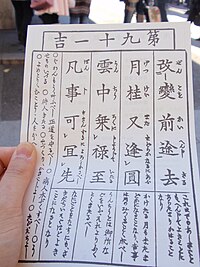御神籤

御神籤(日语:御神籤/おみくじ omikuji)是日本傳統神社、佛寺提供用來占卜個人運勢的求籤活動。參加這一活動者通常要先向寺社支付較少的的賽錢(香火錢),稱爲「初穗料」[1],隨後在寺社提供的抽籤盒中隨機抽取籤紙。籤紙上會以漢字書寫「吉」「凶」等占卜結果,並附有漢詩或和歌以及現代日語解說。[2]時至今日,爲了服務外國人遊客,也有著名寺社會提供用英語書寫的籤紙。[3]
另外,除了判斷一般生活運勢的神籤之外,每間寺社亦提供不同主題的專門神籤,如金運、戀愛、失物、旅行、人際關係、健康等。[2]每年正月時,參加初詣的日本人經常在寺社求御神籤,用來占卜來年的運數。[4]抽到的御神籤在閱讀過後,依傳統要折起並在寺社指定的地點綁定在樹枝或支架上,但亦可帶回家中。[2]
历史
[编辑]
日本現存最早的御神籤源自應永十六年(1409年),保存于岩手縣天台寺。[5]作爲御神籤代表的元三大師百籤來自南宋流行的「天竺靈籤」[6][7],後來在江戶時代以比叡山延暦寺住持良源的通稱「元三大師」命名(比睿山的元山大师堂被称为“神签”的发源地)。[8]据说,观世音菩萨所赐的五言四偈一百偈中,元山大师得到其中之一,并从该偈中得到了应遵循的方法。神签上写着的数字和五言四句,就是因为这一百偈。[9][10]亦有說御神籤的起源更加古老,是上古時代用來決定國家政治以及選拔繼承人的一種神道儀式。[2]
現代很多神社、寺廟亦有設置投幣式自動販賣機,可購買御神籤,甚至有寺廟以機器販賣包有御神籤的漢堡包以吸引人氣。[11]
日本以外
[编辑]據考,美式中餐廳中常見的幸運餅乾很可能來自日本19世紀時的一種點心,名爲「御神籤煎餅」。[12]
參考來源
[编辑]- ^ 「初穂料」など、お供えするときの表書き方について. 神󠄀社󠄁本廳. [2023-08-01]. (原始内容存档于2023-08-01).
- ^ 2.0 2.1 2.2 2.3 おみくじについて. 神󠄀社󠄁本廳. [2023-07-31]. (原始内容存档于2023-07-31).
- ^ Mo Stone. "Fortune on a Paper Strip: Where to Find English Omikuji in Tokyo". Japan Forward. [2023-07-31]. (原始内容存档于2023-07-31).
- ^ 初詣といえばおみくじ!引ける回数は?いつまで引ける?. 村松虚空蔵尊. [2023-07-31]. (原始内容存档于2023-07-31).
- ^ 観音籤及び筒. いわての文化情報大事典. [2021-11-21]. (原始内容存档于2023-07-23).
- ^ Hidaka, Iku. 南宋版『天竺霊籤』原本再現の試み ─後補図75番を例として─. Journal of the Society of Art and Design. 2020, 1. doi:10.34524/jsartdesign.1.0_3.
- ^ Ōno, Izuru. おみくじと天道―元三大師御銭注解考― (PDF). 日本思想史学. 2001-09-30, 33: 130 [2023-07-31]. (原始内容存档 (PDF)于2023-02-25).
- ^ 「おみくじ発祥の地」が比叡山延暦寺に! 1,000年以上前の形式を今なお残す. 伝教大師最澄1200年魅力交流 コミュニケーションサイト「いろり」. [2021-11-21]. (原始内容存档于2023-07-23) (日语).
- ^ おみくじの起源. 妙法寺(蕪村寺). [2021-11-21]. (原始内容存档于2023-03-23).
- ^ Strickmann, Michel; Faure, Bernard. Chinese Poetry and Prophecy: The Written Oracle in East Asia. Stanford University Press. 2005. ISBN 9780804743341.
- ^ 嶋田 知加子. 寺に「おみくじバーガー」自販機 設置した住職の真意. 產經新聞. 2022-03-17 [2023-08-01]. (原始内容存档于2023-08-01).
- ^ Lee, Jennifer 8. "Solving a Riddle Wrapped in a Mystery Inside a Cookie". The New York Times. 2008-01-16 [2023-07-31]. (原始内容存档于2012-04-18).
Text is available under the CC BY-SA 4.0 license; additional terms may apply.
Images, videos and audio are available under their respective licenses.
